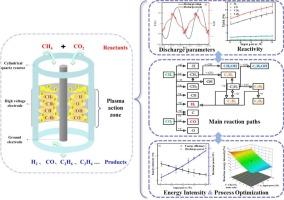Reaction performance of Non-Thermal plasma induced CO2 reforming of CH4 for landfill gas treatment
IF 7.1
2区 环境科学与生态学
Q1 ENGINEERING, ENVIRONMENTAL
引用次数: 0
Abstract
Non-thermal plasma induced reforming of landfill gas into syngas is an attractive alternative approach to resource recovery from small-scale and variable landfill gas streams. The reaction performance, as indicated by reactant conversion, product yield, and reaction energy intensity, of non-thermal plasma-induced CO2 reforming of CH4 has been systematically investigated in a coaxial cylindrical dielectric barrier discharge (DBD) reactor. The reactor surface temperature distribution under varying process parameters is incorporated to investigate its impact on discharge and plasma chemical reaction. It is shown that either an increase in the DBD input power or a reduction in the inlet flow rate leads to greater CH4 and CO2 conversions and syngas yield. A higher CO2 to CH4 molar ratio improves CH4 conversion and syngas yield and reduces the generation of C2 and C3 hydrocarbons. The CH4 and CO2 conversions and H2 and CO yields reached their maximum values of 44.5 %, 27.4 %, 17.1 %, and 20.2 %, respectively, in this experiment. The O∙ radicals generated during CO2 splitting are crucial in enhancing CH4 reforming. The reaction energy intensity, defined as the ratio of the enthalpy change of the desired reactions to the DBD plasma discharge energy, increases effectively with increasing CO2/CH4 molar ratio. The response surface methodology (RSM) is employed to explore the interactions among the three key parameters, and the response surface optimization identified optimal conditions of 80 W input power, 80 ml/min inlet flow rate, and a CH4/CO2 molar ratio of 1.0:2.5, achieving a reaction energy intensity of 19.3 %.

非热等离子体诱导CO2重整CH4处理垃圾填埋气的反应性能
非热等离子体诱导的垃圾填埋气转化为合成气是一种有吸引力的替代方法,可以从小规模和可变的垃圾填埋气流中回收资源。在同轴圆柱形介质阻挡放电(DBD)反应器中,系统地研究了非热等离子体诱导CO2重整CH4的反应性能,包括反应物转化率、产物产率和反应能量强度。研究了不同工艺参数下反应器表面温度分布对放电和等离子体化学反应的影响。结果表明,增加DBD输入功率或降低进口流量均可提高CH4和CO2转化率及合成气产量。较高的CO2 / CH4摩尔比提高了CH4转化率和合成气产率,减少了C2和C3烃的生成。CH4和CO2的转化率以及H2和CO的产率分别达到最大值44.5%、27.4%、17.1%和20.2%。在CO2分裂过程中产生的O∙自由基对促进CH4重整至关重要。反应能量强度,即反应焓变与DBD等离子体放电能量之比,随着CO2/CH4摩尔比的增加而有效增加。采用响应面法(RSM)对3个关键参数之间的相互作用进行了分析,优化后的响应面优化条件为输入功率80 W、进口流量80 ml/min、CH4/CO2摩尔比1.0:2.5,反应能强度为19.3%。
本文章由计算机程序翻译,如有差异,请以英文原文为准。
求助全文
约1分钟内获得全文
求助全文
来源期刊

Waste management
环境科学-工程:环境
CiteScore
15.60
自引率
6.20%
发文量
492
审稿时长
39 days
期刊介绍:
Waste Management is devoted to the presentation and discussion of information on solid wastes,it covers the entire lifecycle of solid. wastes.
Scope:
Addresses solid wastes in both industrialized and economically developing countries
Covers various types of solid wastes, including:
Municipal (e.g., residential, institutional, commercial, light industrial)
Agricultural
Special (e.g., C and D, healthcare, household hazardous wastes, sewage sludge)
 求助内容:
求助内容: 应助结果提醒方式:
应助结果提醒方式:


